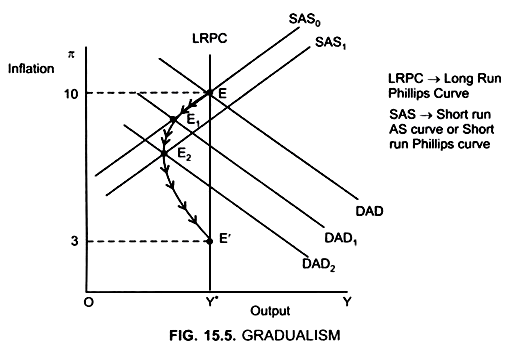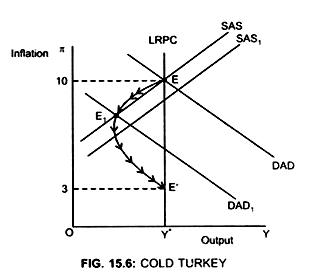Disinflation means the process of reducing inflation rate by reducing growth rate of money supply.
Thus, the basic method of disinflation is to reduce the growth rate of AD by decreasing the growth rate of money supply.
The two alternative strategies used by the monetary authorities are:
I. Gradualism.
ADVERTISEMENTS:
II. Cold Turkey.
I. Gradualism:
Given by Keynes.
A policy of gradualism attempts a slow and steady return to low inflation. The government reduces the growth rate of money gradually over a period of years until it reaches the real growth rate of economy and thus is able to stabilize inflation.
Initially the Economy is in equilibrium at E (Fig. 15.5)
ADVERTISEMENTS:
At point E → DAD = SAS
Inflation rate → 10%
Output is at full employment level → Y*
ADVERTISEMENTS:
If the monetary authorities reduce the money growth rate by a small amount, the AD curve shifts downward from DAD to DAD1.
With SAS constant at SAS0 Economy moves from point E to E1.
At point E1 → DAD1 = SAS
Inflation rate decreases to π1
There is small recession because the output falls below the potential level (full employment level).
Due to decrease in inflation rate, people expect that inflation rate will fall further and as a result, SAS curve shifts downwards to SAS1.
Similarly, a further cut in money growth moves the economy from E1 to E2
(DAD2 = SAS1) where the inflation rate is still lower and this leads to further downward shift in SAS curve.
This process will continue till the economy reaches the potential level at point E’ at a lower inflation rate.
ADVERTISEMENTS:
At point E’ → Inflation rate is lowered to 3%.
Although output is below the full employment level (Y < Y*) that is unemployment (U) is greater than NRU (U*) [U > U*] still, there is no massive recession during the adjustment process.
II. Cold Turkey:
Given by Classical economists:
The cold turkey strategy tries to reduce the inflation rate rapidly by reducing the money growth by a large amount.
ADVERTISEMENTS:
Initially economy is in equilibrium at point E (Fig. 15.6)
At point E → DAD = SAS
Inflation rate → 10%
ADVERTISEMENTS:
Output level is → Y*
To reduce inflation rate money growth is reduced by a large amount.
DAD curve shifts downwards from DAD0 to DAD1
Economy moves from point E to point E1 at point E1, DAD1 = SAS
Inflation rate is lowered drastically to π1 but is accompanied by a considerable recession. This recession is larger than under gradualism.
Due to large fall in inflation rate, SAS curve shifts downwards to SAS1
ADVERTISEMENTS:
The decrease in money growth continues till the economy reaches point E’, that is at potential level and inflation rate of 3%.
Thus, on comparing gradualism and cold turkey we find that immediate recession is larger than under gradualism because the shift in AD is less than that of cold turkey.
The fall in inflation rate is, therefore, faster in cold turkey, SAS shifts down faster than in gradualism.

